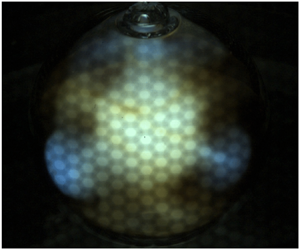Article contents
Convective instability in a stratified ideal gas containing an acoustic field
Published online by Cambridge University Press: 11 March 2021
Abstract

Acoustic radiation pressure acts on fluid inhomogeneities and can drive convection. Inspired by experimental observations of acoustically driven convection inside a spherical plasma bulb, we theoretically investigate the convective modes driven by an acoustic field in a stratified, two-dimensional planar system containing ideal gas and heated from above. In the absence of sound, the system is stable. Gravity determines a threshold acoustic amplitude beyond which part the fluid becomes unstable. Regions of convective stability and instability are separated by the location of the acoustic velocity antinode, and convection results in the regions where the density gradient was not aligned with the gradient in the time-averaged square of the acoustic velocity. At acoustic field levels far beyond threshold, the growth of convective modes with small wavenumbers is suppressed by inertia, while the growth of convective modes with very high wavenumbers is suppressed by viscosity. There is a band of wavenumbers between the two limits with approximately constant growth rate. In the limit of zero gravity and low acoustic fields, the instability grows fastest at a wavenumber that is twice that of the acoustic field. An analogy is drawn between acoustic radiation pressure on inhomogeneities and gravitational forces, which allows us to define an ‘acoustic gravity’ that drives flow approximating thermal convection. We propose that spherical acoustic waves can be used to experimentally study Rayleigh–Bénard convection in a central force, and we lay the theoretical foundations of this approach.
JFM classification
Information
- Type
- JFM Papers
- Information
- Copyright
- © The Author(s), 2021. Published by Cambridge University Press
References
REFERENCES
- 6
- Cited by


